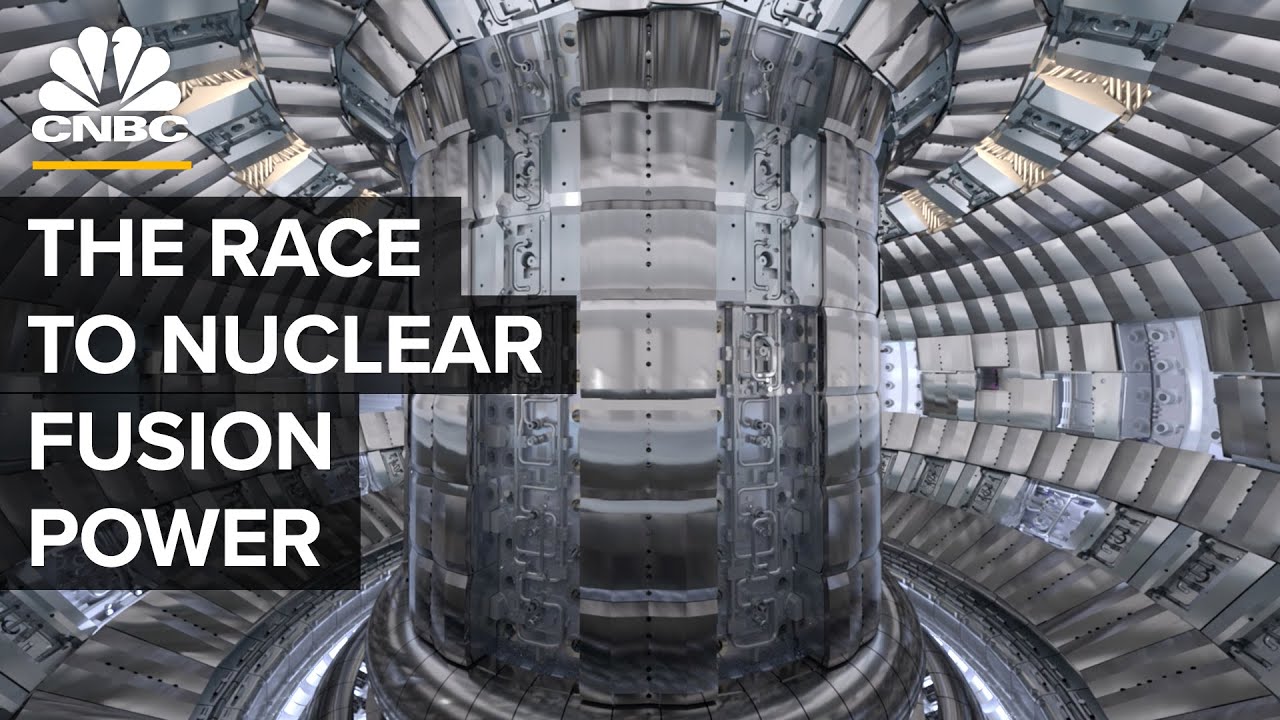This 1,000 tonne magnet is powerful enough to lift an aircraft carrier six
feet off the ground. It's an integral component of ITER, the $22 billion International fusion megaproject in the south of France, and it recently
arrived onsite coming all the way from San Diego, California. It came across the U.S. to Houston. It arrived in July in France. And just
today, well last night actually about one in the morning, we parked the Module here at IO. This magnet is one of the United States' main contributions to the ITER
project, which hopes to be the first to prove the viability of fusion power By generating more energy than it consumes. China, the European Union,
India, Japan, Korea and Russia are also all involved in the effort, Contributing their own reactor components, academics and scientists to the
cause. So what's ITER about? 35 countries, in many cases ideological rivals,
coming together to try to make a common cause to change the energy legacy. The idea of fusion power has intrigued scientists for nearly 100 years,
when they first discovered that it's the process that powers the sun and The stars. The nuclear reactors that exist today are powered by fission,
that is atoms splitting apart. But a fusion reaction, which occurs when Atoms fuse together, could generate four times more energy than fission,
and about 4 million times more than burning coal, without producing any Greenhouse gases. And unlike today's reactors, fusion does not generate
long-term radioactive waste, the reactors cannot melt down and the fuel, Hydrogen, is readily available. Basically, it would be a huge game changer
for the energy industry. But while there have been some recent Breakthroughs, it will likely take decades before we start generating
electricity from fusion. Yes, it will take time. We're not going to solve the problem for the planet
next week, next month, next year, not even in the next decade. But we are The solution for the planet eventually. In a fusion reaction, extreme temperatures and intense pressure cars
hydrogen atoms to form a plasma, a state of matter is similar to gas except That it can conduct electricity and respond to magnetic fields. Within the
plasma, hydrogen atoms fuse together to form helium atoms, losing some mass In the process, which is converted into vast amounts of energy. ITER is
pursuing magnetic confinement fusion, which uses powerful magnets, like the One that was just delivered, to drive current through the plasma, contain
it and control it. If all goes according to plan, ITER will produce first Plasma by 2025, which will confirm that the machine works. In order for fusion to take place, we need the plasma to be 150 million
centigrades. So no material in the world can manage that kind of Temperature. These magnets, they create a magnetic cage. Remember that the
particles are charged, electrically charged, so magnets can control and Shape the plasma Tokamaks are the doughnut shaped devices used for magnetic confinement
fusion, and so long as technologies like magnet strength remain constant, a Tokamak's size generally determines its energy potential. So far, no
machine in the world has produced net energy. But ITER's eventual goal is To generate 500 megawatts of fusion power from 50 megawatts of heating
power, a tenfold return on energy. That's why it's designed to be the Largest tokamak ever built. The project's many components are manufactured
by member nations around the world and paid for by their governments. The Parts are transported to ITER via massive ships and trucks. And before
being integrated with the reactor itself, all components are brought into The Assembly Hall where Haupt is standing. So what you see behind me is a 90 meter long, 60 meter high and about 60
meter wide work hole where everything is being prepared before it is Actually moving into the tokamak pit, where the fusion machine is being
built. Huge cranes carry components over the wall separating the assembly hall
from the reactor. Pieces of all shapes and sizes, weighing up to 1,250 Tonnes, have made the journey so far, as construction of the ITER reactor
is now about 80% complete. When fully assembled, the reactor will be 23,000
Tonnes, and combined with the Assembly Hall, will occupy an area of over
100 acres. The hope is that scientific and technological learnings will Lead to smaller, more efficient reactors. Already there's been major
advances when it comes to building super powerful magnets. But though ITER Will likely be clunkier and costlier than reactors to come, Luce says
that's to be expected with any new technology. The role of ITER is not closing the book, but reducing all the uncertainty
of the scientific case and begin the technology case. It's like the Wright Brothers flying, they showed it was possible and then there was rapid
industrialization after that. That's our hopeful model for ITER too. While ITER is the largest fusion reactor under construction, it's certainly
not the only one, and it's not a given that it will be the first to produce Net energy. That's because in recent years the private fusion industry,
funded by venture capitalists and billionaire investors, has boomed. You've seen 2 billion U.S. dollars equivalent being invested in the fusion
space. And you've seen forward-thinking people – maybe you like them, maybe You don't – Bill Gates, Jeff Bezos, Elon Musk, those types of visionaries,
they're all investing in one form or another in fusion technology. A lot of the what the private companies are doing is building out machines
with a good enough understanding of plasma physics. We know that when we Build it, fusion will work. We don't know exactly how. And so there's a lot
of science that can be done in the massive scientific undertaking of ITER. Since ITER's primary goal is to serve as a proof-of-concept and uncover key
learnings, it won't produce electricity for the grid. But private companies Have an eye towards rapid commercialization of smaller-scale reactors. We're building off of the vast amount of scientific development and
understanding that has grown up over decades of academic fusion research, Combined with technological advances in all sorts of other areas including
AI, high speed computing, new high technology materials, and moving Rapidly, moving at the speed of business, to commercialize fusion power. The latest commercial endeavor to make headlines is Commonwealth Fusion
Systems, an MIT spinoff company that has built the most powerful fusion Magnet in the world, capable of generating a stronger magnetic field than
ITER in a much smaller space. The world learned of this breakthrough the Same day that ITER was preparing for the onsite arrival of its giant
magnet, previously thought to be the world's most powerful. But Coblentz Says that competition in the fusion community, if one can even call it
that, is unusually friendly. I think it's fantastic. And it's not really a competition, because you will
hear them, the private enterprises, and our group, you'll hear us all say That we're going to be cheerleaders for whoever gets there first. Lawrence Livermore National Laboratory also recently made news as it got
closer to producing net energy than ever before, using 192 huge lasers to Generate 70% as much energy as went into the reaction. The hope is that
once fusion reaches the breakeven point, investors and governments alike Will recognize the potential and financial support will pour in. It might be done by a national lab, or by an international consortium or
the private sector, but it's coming soon. And then once that happens, the Race will be to transition that from a scientific experiment into a
commercial, sellable powerplay The economic case for fusion, however, remains far from certain. ITER,
projected to cost $22 billion, has far exceeded its initial estimate of $5 Billion. Some blame this on management problems, some on the sheer
technical difficulty of building out a reactor of this size. The current ITER Direcor-General says the original estimate was always unrealistic. So
while Holland eventually hopes to see fusion producing electricity at rates That are competitive with natural gas or coal, that's a far off
proposition. Initially, getting fusion energy on the grid will likely Involve a good deal of government support, Because the unit cost is high, the payoff time to industry will not be so
fast. It would be a high risk for an industry to take on something like ITER alone. So there will have to be government sponsorship, government
security, or direct government funding of it.
In the infrastructure bill, you know which is working its way through
Congress right now, there is $325 million for public-private partnerships, About $2.2 billion overall for fusion energy. Proving the viability of fusion is one thing, deploying it at scale is
another. And many say that how fast we do that is largely a matter of Political will. Is it conceivable by 2035? Sure. Is it likely? Not if we're spending what
we're spending now. For me, it's not how long before we get fusion, it is Treat this like Covid. It was 18 months ago, when we were all told by the
smartest epidemiologists on the planet that the fastest you could get a Vaccine for Covid was four years. But the countries of the world, they came
together and they put $94 billion into Covid vaccine research. That's four Or five times the cost of ITER. But even if the most optimistic fusion timelines come to bear, and the tech
is successfully commercialized sometime in the 2030s, the world can't wait Until then to begin rapid decarbonisation. And that means turning to the
renewable energy technologies that we have available today. Yes, we need to be doing solar, wind, anything that bridges the gap for us.
But they're not going to supply, in my opinion, what civilization needs. Experts say that we need an always on source of green power to keep cities
and industries running. And solar and wind can't provide that if the Weather conditions aren't right Population is going to grow. Half the world is living in standards which
they would like to very much improve. Takes energy. And so it will happen, It's a matter of whether it's going to be traumatic or planned. This is not just we have to get to the moon. We have to get to the moon and
then we have to sell tickets. Right? So this is a business proposition as Well as a scientific proposition as well as an academic proposition. And whether it's free markets, governments, or likely some combination of
the two that drives the adoption of fusion energy, first someone needs to Prove that it will work. And over this past year, they've gotten a lot
closer. After the proof of principle exists, the rapid industrialization can start
and the possibility effect takes over. And then what I would hope is that The gates open, because when people can see the possibility, why not do it?





